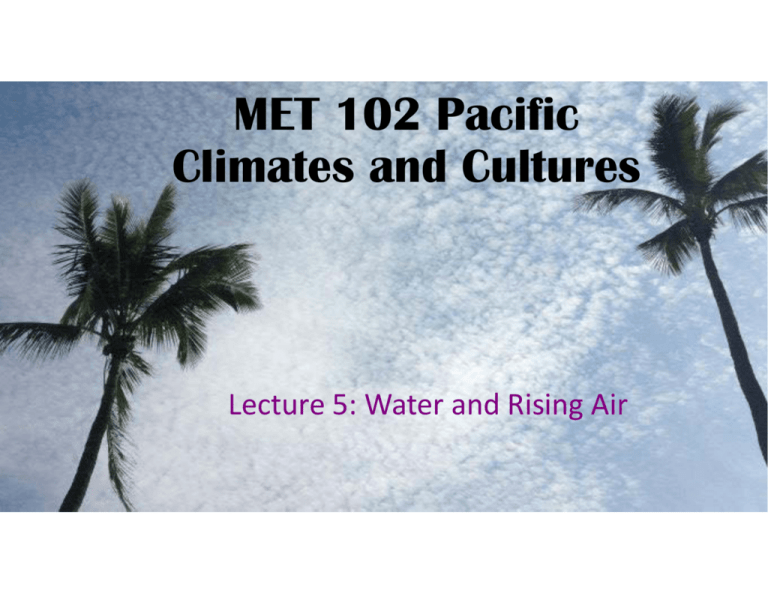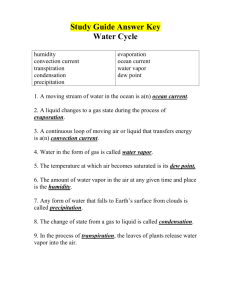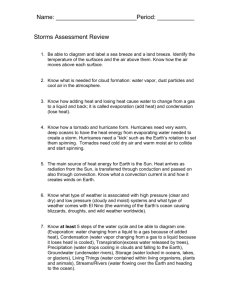Lecture 5 PDF
advertisement

MET 102 Pacific Climates and Cultures Lecture 5: Water and Rising Air Discussion – Ackerman & Knox • What are the different ways of measure water vapor in the air? • • • • Mixing Ratio Vapor Pressure Relative Humidity Dew Point/Frost Point • What are the 4 main ways are for make air rise? • • • • Orographic Lifting Frontal Wedging Convection (Differential Heating) Convergence Discussion – Ackerman & Knox We’re actually going to talk about these in depth on Thursday: • What are the main ways we classify clouds? • Shape • Height in the atmosphere • Whether or not they rain! • Do you think fog happens often on the Pacific Islands? Why or why not? • Fog can happen anywhere if the temperature and moisture content allow. • The water and air may not get cold enough on most islands to allow for fog formation, however, valley fog on high islands is a possibility Water is Everywhere • Oceans • Rivers/Streams/Waterfalls • Pools/Lakes • Air • Soil • Living tissue • Snow/Ice/Glaciers • Water, water, everywhere, but not a drop to drink…. Oceans account for most of water (>97%) • Not readily useable by humans or plants • Ice sheets in Antarctica and Greenland (~3%) • Atmosphere has only a little (0.001%) “The Hydrologic Cycle” Condensation Evaporation Precipitation Run Off Transpiration Infiltration Processes Involving Water in the Atmosphere • Evaporation – Requires Energy • The process by which a liquid is transformed into a gas • Powered by the Sun! • Solar Radiation heat up the water molecules until they are “freed” from the liquid state • Heat is absorbed during evaporation • Condensation – Releases Energy • The change from a gas to a liquid • Responsible for the formation of clouds • Heat is released during condensation Processes Involving Water in the Atmosphere • Precipitation – Over Land & Oceans • Falling liquid or solid in the atmosphere. • Returned the water to the ocean or soaks into the ground • Balances Evaporation • Average annual precipitation equals evaporation. • Transpiration • The release of water vapor to the atmosphere by plants • Plants uptake water through their roots that fell as precipitation • Not as important as evaporation Water Vapor Content of the Air • Humidity • The general term used to describe the amount of water vapor in the air • Other Ways of thinking about it: • Mixing Ratio • Vapor Pressure • Relative Humidity • Dew Point/Frost Point Mixing Ratio • The MASS of water vapor in a unit of air compared to the remaining MASS of dry air. • NOT affected by changes in temperature and pressure!!! • MASS doesn’t change as a function of temperature. Mixing Ratio = Mass of water vapor (grams) Mass of dry air (kilograms) Vapor Pressure • That part of the total atmospheric pressure attributable to its water‐ vapor content. • As more water vapor is added to dry air the vapor pressure increases. • MASS doesn’t change as a function of temperature. Initially more molecules leave the surface of the water than return. Over time: number of molecules leaving = the number molecules returning This is SATURATION Saturation Vapor Pressure • When air is saturated the pressure exerted by the motion of the water vapor molecules is called the Saturation Vapor Pressure. • Varies as a function of temperature • You can “FIT” more water vapor in warmer air. Relative Humidity • The ratio of the air’s actual water vapor content compared with the amount of water vapor required for saturation at that temperature and pressure Relative Humidity = Water vapor content X 100 percent Water vapor capacity Natural Changes in Humidity 1. Daily changes in temperatures (daylight verses nighttime temperatures) 2. Temperature changes that result as air moves horizontally from one location to another 3. Temperature changes caused as air moves vertically in the atmosphere Dew Point Temperature 59 F – 68 F • The temperature at which air needs to be cooled to reach saturation • It is a measure of the actual moisture content of a parcel of air. • The term dew point stems from the fact that during the night objects at the surface often cool below the dew‐point are a coated with dew. • When the dew point exceeds ~65F it is considered humid by most people • A dew point above 75F is considered unbearable. 1. Orographic Lifting 2. Frontal Wedging 3. Convergence 4. Localized Convective Lifting (differential heating) Processes that Lift Air Lifted Condensation Level (LCL) • The height at which rising air that is cooling at the dry adiabatic rate becomes saturated and condensation begins. Why most clouds have FLAT bottoms!!! Orographic Lifting • • Air is forced to rise over a mountainous or topographic barrier Rain shadow desert Frontal Wedging • • Warmer, less dense air, is forced over cooler, denser air Front – when warm and cold air collide Localized Convective Lifting • Unequal heating of Earth’s surface causes pockets of air to be warmed more than the surrounding air. • Buoyant parcels (thermals) of hot air rise. • After reaching the LCL they form clouds. Convergence When air flows in from more than one direction (not a front) can collides It cannot go down. It goes up. Often happens over slands and other egions where two bodies of water are ocated closely ogether Air Parcels… What are they? • • A Parcel is an imaginary volume of air • Typically a few hundred cubic meters in volume • Acts independently of the surrounding air • It is assumed that no heat is transferred into, or out of it • HIGHLY IDEALIZED We use them to talk about the likelihood that air will rise up or sink down. • We need to know this if we want to predict if clouds will form. Adiabatic Temperature Changes • When heat is neither added nor subtracted • Result when air is compressed or allowed to expand When air is allowed to expand, it COOLS. When air is compressed, it WARMS. Dry Adiabatic Lapse Rate COOLS 18°C 19°C 20°C The change in temperature due to a change in altitude of a non‐ condensing parcel • Abbreviated DALR • • • DALR = 1°C/100m DALR = 10°C/1000m DALR = 5.5°F/1000ft 17°C 18°C 19°C 20°C WARMS 17°C • COOLS 18.5°C 19.0°C 18.5°C 19.5°C 19.5°C 20.5°C 20°C 21.5°C WARMS at the DALR Wet Adiabatic Lapse Rate • The change in temperature due to a change in altitude of a condensing parcel • Abbreviated WALR • • • WALR = ~0.6°C/100m WALR = ~6°C/1000m WALR = ~3.3°F/1000ft








